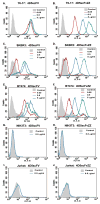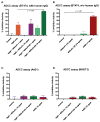scFv-based "Grababody" as a general strategy to improve recruitment of immune effector cells to antibody-targeted tumors
- PMID: 23396586
- PMCID: PMC3630244
- DOI: 10.1158/0008-5472.CAN-12-3920
scFv-based "Grababody" as a general strategy to improve recruitment of immune effector cells to antibody-targeted tumors
Abstract
Recruitment of immune cells to tumor cells targeted by a therapeutic antibody can heighten the antitumor efficacy of the antibody. For example, p185(her2/neu)-targeting antibodies not only downregulate the p185(her2/neu) kinase (ERBB2) but also trigger complement-dependent cytotoxicity (CDC) and antibody-dependent cellular cytotoxicity (ADCC) through the antibody Fc region. Here, we describe a generalized strategy to improve immune cell recruitment to targeted cancer cells, using a modified scFv antibody we call a "Grababody" that binds the target protein and endogenous immunoglobulins. The model system we used to illustrate the use of this platform recognizes p185(her2/neu) and includes an IgG binding domain. The recombinant scFv Grababody that was created recruited circulating human IgGs and attracted immune cells carrying Fc receptors to tumor cells that expressed p185(her2/neu). The presence of the IgG binding domain significantly enhanced CDC and ADCC activity and improved antitumor activity in vivo. Our results illustrate a novel general approach to improve antibody-like proteins for therapeutic applications.
©2013 AACR.
Conflict of interest statement
Figures





Similar articles
-
Regulation of antibody-dependent cellular cytotoxicity by IgG intrinsic and apparent affinity for target antigen.J Immunol. 2007 Sep 1;179(5):2815-23. doi: 10.4049/jimmunol.179.5.2815. J Immunol. 2007. PMID: 17709495
-
Combined Fc-protein- and Fc-glyco-engineering of scFv-Fc fusion proteins synergistically enhances CD16a binding but does not further enhance NK-cell mediated ADCC.J Immunol Methods. 2011 Oct 28;373(1-2):67-78. doi: 10.1016/j.jim.2011.08.003. Epub 2011 Aug 9. J Immunol Methods. 2011. PMID: 21855548
-
Increasing the affinity for tumor antigen enhances bispecific antibody cytotoxicity.J Immunol. 2001 May 15;166(10):6112-7. doi: 10.4049/jimmunol.166.10.6112. J Immunol. 2001. PMID: 11342630
-
The "less-is-more" in therapeutic antibodies: Afucosylated anti-cancer antibodies with enhanced antibody-dependent cellular cytotoxicity.MAbs. 2018 Jul;10(5):693-711. doi: 10.1080/19420862.2018.1466767. MAbs. 2018. PMID: 29733746 Free PMC article. Review.
-
G-CSF-stimulated PMN in immunotherapy of breast cancer with a bispecific antibody to Fc gamma RI and to HER-2/neu (MDX-210).J Hematother. 1995 Oct;4(5):415-21. doi: 10.1089/scd.1.1995.4.415. J Hematother. 1995. PMID: 8581378 Review.
Cited by
-
Lysosome-dependent p300/FOXP3 degradation and limits Treg cell functions and enhances targeted therapy against cancers.Exp Mol Pathol. 2013 Aug;95(1):38-45. doi: 10.1016/j.yexmp.2013.04.003. Epub 2013 May 2. Exp Mol Pathol. 2013. PMID: 23644046 Free PMC article.
-
Empowering scFv with effector cell functions for improved anticancer therapeutics.Oncoimmunology. 2013 Jun 1;2(6):e24439. doi: 10.4161/onci.24439. Epub 2013 May 8. Oncoimmunology. 2013. PMID: 23894701 Free PMC article.
-
Therapeutic potential of an anti-HER2 single chain antibody-DM1 conjugates for the treatment of HER2-positive cancer.Signal Transduct Target Ther. 2017 May 19;2:17015. doi: 10.1038/sigtrans.2017.15. eCollection 2017. Signal Transduct Target Ther. 2017. PMID: 29263918 Free PMC article.
-
Clinical development of immunotherapies for HER2+ breast cancer: a review of HER2-directed monoclonal antibodies and beyond.NPJ Breast Cancer. 2020 Mar 12;6:10. doi: 10.1038/s41523-020-0153-3. eCollection 2020. NPJ Breast Cancer. 2020. PMID: 32195333 Free PMC article. Review.
-
HED, a Human-Engineered Domain, Confers a Unique Fc-Binding Activity to Produce a New Class of Humanized Antibody-like Molecules.Int J Mol Sci. 2023 Mar 30;24(7):6477. doi: 10.3390/ijms24076477. Int J Mol Sci. 2023. PMID: 37047449 Free PMC article.
References
-
- Scott AM, Wolchok JD, Old LJ. Antibody therapy of cancer. Nature reviews Cancer. 2012;12:278–87. - PubMed
-
- Krapp S, Mimura Y, Jefferis R, Huber R, Sondermann P. Structural analysis of human IgG-Fc glycoforms reveals a correlation between glycosylation and structural integrity. Journal of molecular biology. 2003;325:979–89. - PubMed
-
- Muthing J, Kemminer SE, Conradt HS, Sagi D, Nimtz M, Karst U, et al. Effects of buffering conditions and culture pH on production rates and glycosylation of clinical phase I anti-melanoma mouse IgG3 monoclonal antibody R24. Biotechnology and bioengineering. 2003;83:321–34. - PubMed
-
- Suzuki E, Niwa R, Saji S, Muta M, Hirose M, Iida S, et al. A nonfucosylated anti-HER2 antibody augments antibody-dependent cellular cytotoxicity in breast cancer patients. Clinical cancer research: an official journal of the American Association for Cancer Research. 2007;13:1875–82. - PubMed
-
- Jefferis R. Glycosylation as a strategy to improve antibody-based therapeutics. Nature reviews Drug discovery. 2009;8:226–34. - PubMed
Publication types
MeSH terms
Substances
Grants and funding
LinkOut - more resources
Full Text Sources
Other Literature Sources
Research Materials
Miscellaneous

